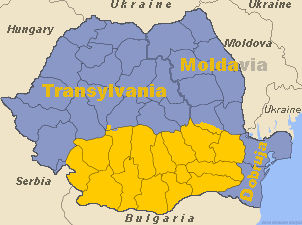This is an old revision of this page, as edited by Bogdangiusca (talk | contribs) at 14:51, 6 March 2004 ({{msg:Romanian_historical_regions}}). The present address (URL) is a permanent link to this revision, which may differ significantly from the current revision.
Revision as of 14:51, 6 March 2004 by Bogdangiusca (talk | contribs) ({{msg:Romanian_historical_regions}})(diff) ← Previous revision | Latest revision (diff) | Newer revision → (diff)
Wallachia (also spelt Walachia) formed a Romanian principality in eastern Europe from the late Middle Ages until the mid-19th century.
The capital city changed over time, from Curtea de Arges to Targoviste and finally Bucharest.
 Map of Romania with Wallachia in brown
Map of Romania with Wallachia in brown
History
Beginning with the tenth century, Byzantine, Slavic and Hungarian sources, and later - Occidental sources - mention the existence of statal entities peopled by Romanians under a leader known as kneaz or voyevod - at first in Transylvania and Dobrogea (Dobrudja), then in the twelfth-thirteenth century in the territories east and south of the Carpathian Mountains. A specific characteristic of Romanian history in the Middle Ages, until the Modern Period, is that they lived in three adjacent, but autonomous principalities - Wallachia, Moldavia and Transylvania.
In the fourteenth century, along with the decline of the neighboring empires (Poles, Hungarians, Tatars), several feudal states formed in the south and the east of the Carpathian Mountains - Wallachia under Basarab I (around 1360) and Moldavia under Bogdan I (around 1359).
In the second half of the fourteenth century, a new threat appeared - the Ottoman Empire. After having first gained a foothold in Europe in 1354, the Ottoman Turks reached the south bank of the Danube in 1396.
Alone or allied with the neighbouring Christian countries, rather than in alliance with the other two Romanian principalities, voyevods Mircea cel Batran (1386-1418) and Vlad Tepes (1456-1462) of Wallachia and Stefan cel Mare (1457-1504), voyevod of Moldavia and Iancu de Hunedoara, prince of Transylvania fought many defensive battles against the Ottomans, preventing them from expanding into Central Europe.
As the whole Balkan Peninsula became Turkish territory, and following the fall of Constantinople to Mehmed II in 1453, the Romanian principalities had to accept the suzerainty of the Ottoman Empire for more than three centuries - though there were a few attempts to regain independence: (Mihai Viteazu in 1600 managed to unite for a short period of time all the three principalities).
The tribute paid to the Turks allowed Wallachia (and Moldavia too) to maintain its own statal entity, its own politics and its own military and administrative structures.
Important rulers:
- Litovoi, voivode on the east side of the Olt river, 1247-1277,
- Seneslau, voivode on west side of the Olt river, at Arges, c.a.1247
- Barbat, c.a.1277-c.a.1290
- Tihomir, c.a.1290-c.a.1310
- Basarab I, about 1310 - 1352
- Vladislav I or Vlaicu-Voda, 1364-c.a.1377
- Mircea cel Batrin (Mircea the Old), 1386-1418
- Vlad Tepes (Vlad the Impaler), 1448, 1456-1462, 1476
- Neagoe Basarab, 1512-1521
- Mihai Viteazul (Michael the Brave), 1593 - 1601
- Alexander John Cuza, 1859 - 1866
See also the complete List of Wallachian rulers.
In 1859, Wallachia voted to unite with Moldavia to form the state of Romania, under the rule of Alexander John Cuza.
Geography
Wallachia was situated north of the Danube and south of the Carpathian Mountains.
Its neighbours were the Ottoman Empire to the south, Transylvania to the north-west and Moldavia to the north-east.
| Banat |
|
|---|---|
| Dobruja |
|
| Moldavia |
|
| Transylvania | |
| Wallachia | |
| |